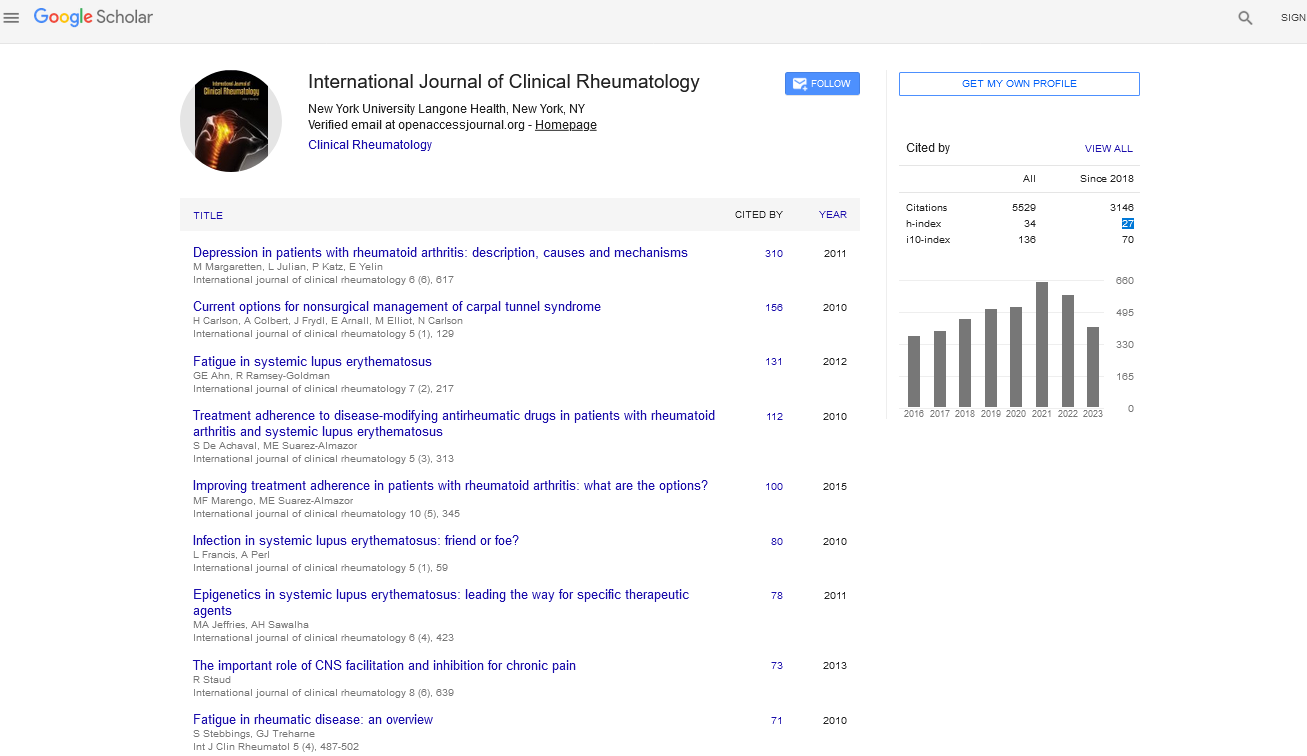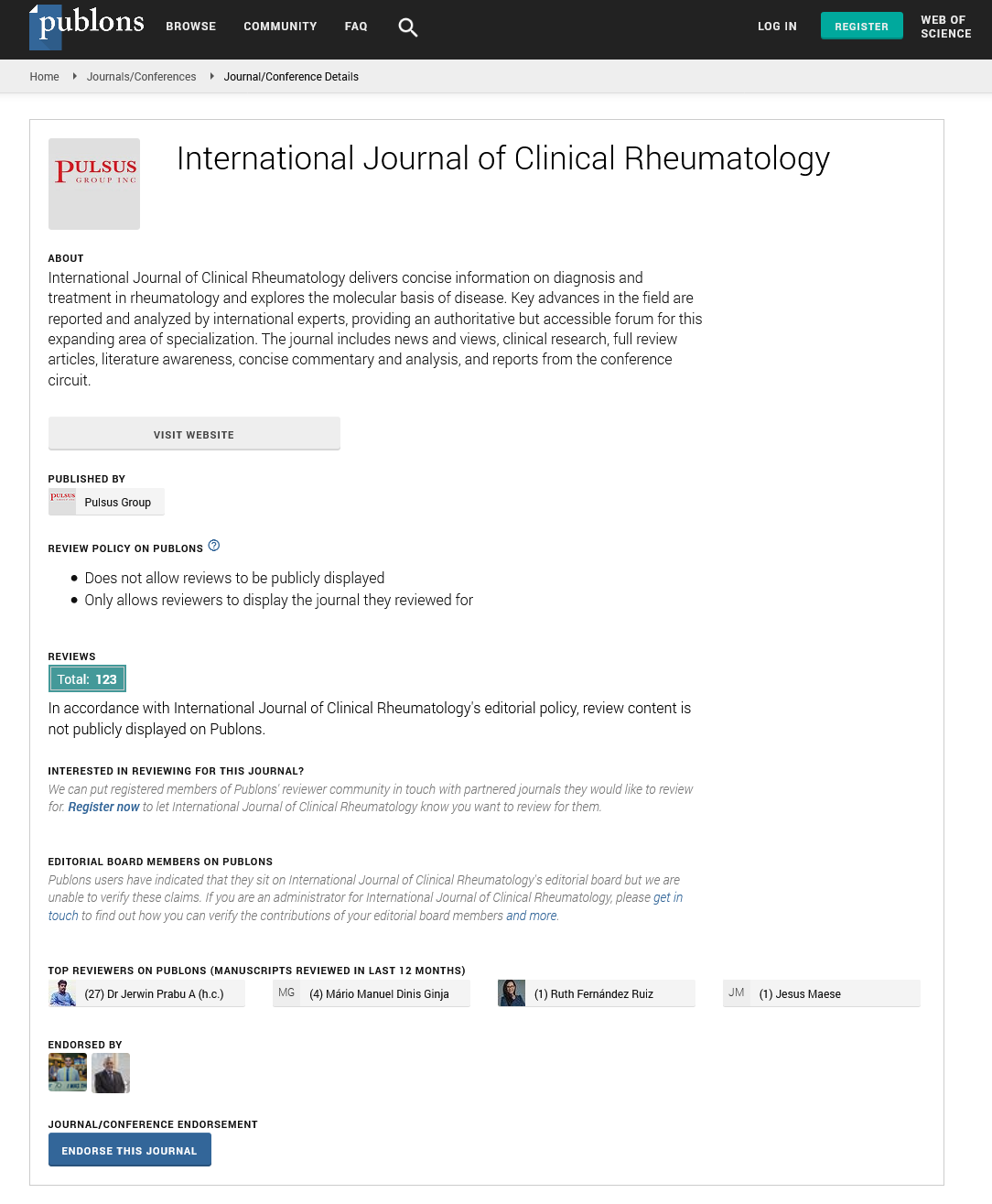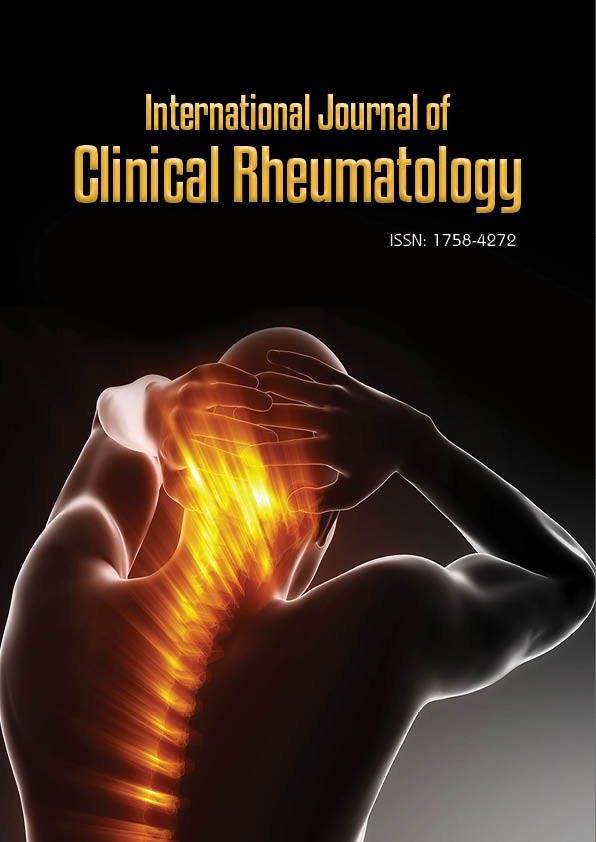Editorial - International Journal of Clinical Rheumatology (2025) Volume 20, Issue 1
The Role of Gut Microbiota in the Pathogenesis of Rheumatoid Arthritis
Olivia Harris*
Department of Rheumatology, Pontificia Universidad Católica de Chile, Santiago, Chile
- *Corresponding Author:
- Olivia Harris
Department of Rheumatology, Pontificia Universidad Católica de Chile, Santiago, Chile
E-mail: olivia.harris1988@protonmail.com
Received: 02-Jan-2025, Manuscript No. fmijcr-25-162968; Editor assigned: 04- Jan-2025, Pre-QC No. fmijcr-25-162968 (PQ); Reviewed: 18-Jan-2025, QC No. fmijcr-25-162968; Revised: 23-Jan-2025, Manuscript No. fmijcr-25-162968 (R); Published: 30-Jan-2025, DOI: 10.37532/1758- 4272.2025.20(1).383-385
Abstract
Emerging evidence suggests that the gut microbiota plays a significant role in the pathogenesis of rheumatoid arthritis (RA). Dysbiosis, an imbalance in the gut microbial community, has been implicated in triggering immune system activation, inflammatory responses, and the development of autoimmune diseases. This article explores the gut-joint axis, examining how the gut microbiota might influence RA pathogenesis and how microbiome-based interventions could offer new therapeutic opportunities for RA patients.
Introduction
The human microbiota, especially the gut microbiota, is known to play a critical role in immune system regulation. Recent studies suggest that dysbiosis in the gut microbiome may contribute to the development of autoimmune diseases, including rheumatoid arthritis (RA) [1,2]. Researchers have hypothesized that gut-derived inflammatory signals may contribute to synovial inflammation and joint damage in RA. Identifying the link between the gut microbiota and RA pathogenesis could offer novel therapeutic strategies to prevent or treat the disease. Dysbiosis in the gut microbiota has been observed in RA patients, with certain bacterial species showing increased abundance, while others are reduced. For example, Prevotella and Fusobacterium species, both pro-inflammatory bacteria, have been found in higher concentrations in RA patients compared to healthy individuals. These bacteria may trigger the production of pro-inflammatory cytokines that activate immune responses, leading to systemic inflammation and the production of autoantibodies such as ACPA, which are hallmark features of RA. Furthermore, specific microbial patterns have been shown to influence the Th17 cell pathway, a critical driver of inflammation in RA. The production of interleukin-17 (IL-17) by Th17 cells has been implicated in the pathogenesis of RA, and certain gut bacteria may stimulate these cells, exacerbating joint inflammation [3-6]. Given the role of the gut microbiota in RA, modulating the microbiome represents a promising therapeutic avenue. Strategies such as probiotics, prebiotics, and fecal microbiota transplantation (FMT) are being explored to restore a healthy gut microbial balance. Animal studies have shown that altering the gut microbiota can reduce inflammation and delay the onset of arthritis. Early human clinical trials investigating the use of probiotics and dietary interventions have shown promising results, although larger studies are needed to determine the clinical efficacy of these approaches [7-10].
Conclusion
The gut microbiota plays a pivotal role in the development of rheumatoid arthritis by influencing immune system regulation and inflammatory pathways. Modulating the gut microbiome represents a novel therapeutic strategy for RA, with potential benefits for patients who do not respond to conventional treatments. Further research is needed to fully understand the mechanisms involved and to translate these findings into effective clinical therapies.
References
- Thorn, Caroline F. Doxorubicin Pathways: Pharmacodynamics and Adverse Effects. Pharmacogenet Genomics. 21, 440-446 (2011).
- Brunelli D, Polonelli T, Benini L. Ultra-low energy pest detection for smart agriculture. IEEE Sens J. 1-4 (2020).
- Crippen TL, Poole TL.Conjugative transfer of plasmid-located antibiotic resistance genes within the gastrointestinal tract of lesser mealworm larvae,Alphitobius diaperinius(Coleoptera: Tenebrionidae). Foodborne Pathog Dis. 7, 907-915 (2009).
- Dwyer, Claire. ‘Highway to Heaven’: the creation of a multicultural, religious landscape in suburban Richmond, British Columbia. Soc Cult Geogr. 17, 667-693 (2016).
- Südfeld S.Post-induction hypotension and early intraoperative hypotension associated with general anaesthesia. Br J Anaesth. 81, 525-530 (2017).
- Makam AN, Nguyen OK. An Evidence-Based Medicine Approach to Antihyperglycemic Therapy in Diabetes Mellitus to Overcome Overtreatment. Circulation. 135, 180-195 (2017).
- Chandalia M, Lutjohann D, von Bergmann K et al. Beneficial effects of high dietary fiber intake in patients with type 2 diabetes mellitus. N Engl J Med. 342, 1392-8 (2000).
- Gething MJ. Role and regulation of the ER chaperone BiP. Seminars in Cell and Developmental Biology. 10, 465-472 (1999).
- Schepers E, Meert N, Glorieux G et al. P-cresylsulphate, the main in vivo metabolite of p-cresol, activates leucocyte free radical production. Nephrol Dial Transplant. 22, 592-596 (2006).
- Ricci Z, Ronco C, Amico GD et al. Practice patterns in the management of acute renal failure in the critically ill patient: an international survey. Nephrol Dial Transplant. 21, 690-696 (2006).
Indexed at, Google Scholar, Crossref
Indexed at, Google Scholar, Crossref
Indexed at, Google Scholar, Crossref
Indexed at, Google Scholar, Crossref
Indexed at, Google Scholar, Crossref
Indexed at, Google Scholar, Crossref
Indexed at, Google Scholar, Crossref
Indexed at, Google Scholar, Crossref


